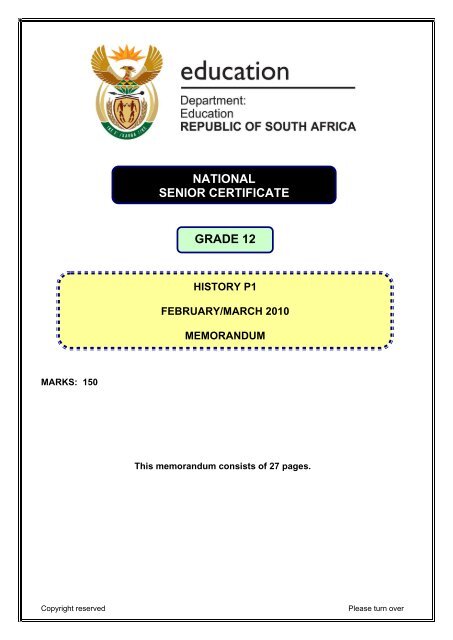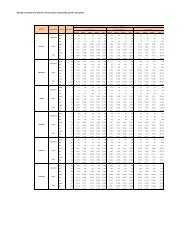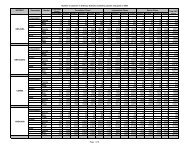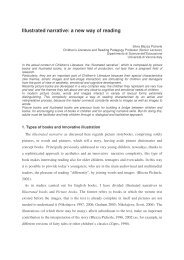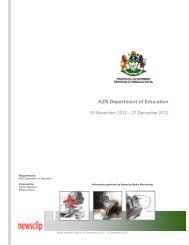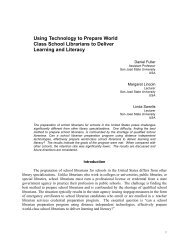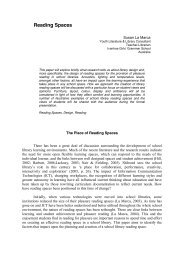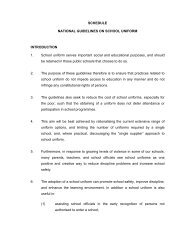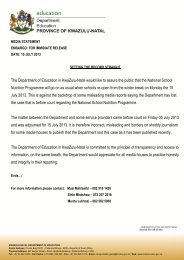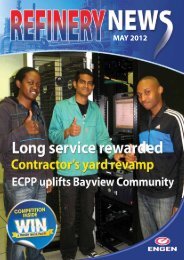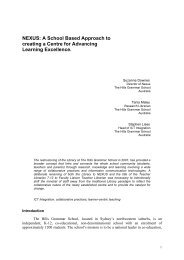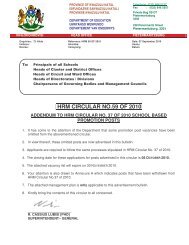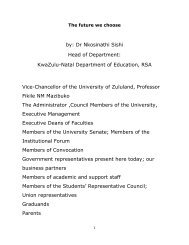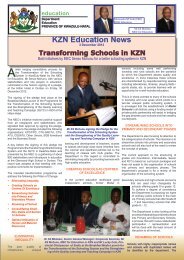History P1 Feb-March 2010 Eng Memo - KZN Education
History P1 Feb-March 2010 Eng Memo - KZN Education
History P1 Feb-March 2010 Eng Memo - KZN Education
You also want an ePaper? Increase the reach of your titles
YUMPU automatically turns print PDFs into web optimized ePapers that Google loves.
NATIONAL<br />
SENIOR CERTIFICATE<br />
GRADE 12<br />
HISTORY <strong>P1</strong><br />
FEBRUARY/MARCH <strong>2010</strong><br />
MEMORANDUM<br />
MARKING GUIDELINE<br />
MARKS: 150<br />
This memorandum consists of 27 pages.<br />
Copyright reserved<br />
Please turn over
<strong>History</strong>/<strong>P1</strong> 2 DoE/<strong>Feb</strong>. – <strong>March</strong> <strong>2010</strong><br />
NSC – <strong>Memo</strong>randum<br />
1. SOURCE-BASED QUESTIONS<br />
1.1 The following Learning Outcomes and Assessment Standards will be assessed<br />
in this question paper:<br />
LEARNING<br />
OUTCOMES<br />
Learning<br />
Outcome 1<br />
(Historical<br />
enquiry)<br />
ASSESSMENT STANDARDS<br />
THE ABILITY OF THE LEARNER TO:<br />
1. Formulate questions to analyse concepts for investigation within<br />
the context of what is being studied. (Not for examination<br />
purpose).<br />
2. Access a variety of relevant sources of information in order to<br />
carry out an investigation. (Not for examination purpose).<br />
3. Interpret and evaluate information and data from sources.<br />
4. <strong>Eng</strong>age with sources of information evaluating the usefulness of<br />
the sources for the task, including stereotypes, subjectivity and<br />
gaps in the evidence available to the learners.<br />
Learning<br />
Outcome 2<br />
(Historical<br />
concepts)<br />
Learning<br />
Outcome 3<br />
(Knowledge<br />
construction<br />
and<br />
communication)<br />
1. Analyse historical concepts as social constructs.<br />
2. Examine and explain the dynamics of changing power relations<br />
within the societies studied.<br />
3. Compare and contrast interpretations and perspectives of<br />
events, people’s actions and changes in order to draw<br />
independent conclusions about the actions or events.<br />
1. Identify when an interpretation of statistics may be controversial<br />
and engage critically with the conclusions presented by the data.<br />
2. Synthesise information to construct an original argument using<br />
evidence to support the argument.<br />
3. Sustain and defend a coherent and balanced argument with<br />
evidence provided and independently accessed.<br />
4. Communicate knowledge and understanding in a variety of ways<br />
including discussion (written and oral) debate, creating a piece of<br />
historical writing using a variety of genres, research<br />
assignments, graphics, oral presentation.<br />
Copyright reserved<br />
Please turn over
<strong>History</strong>/<strong>P1</strong> 3 DoE/<strong>Feb</strong>. – <strong>March</strong> <strong>2010</strong><br />
NSC – <strong>Memo</strong>randum<br />
1.2 The following levels of questions were used to assess source-based questions.<br />
LEVELS OF SOURCE-BASED QUESTIONS<br />
LEVEL 1 (L1)<br />
LEVEL 2 (L2)<br />
LEVEL 3 (L3)<br />
<br />
<br />
<br />
<br />
<br />
<br />
<br />
<br />
<br />
<br />
<br />
<br />
Extract relevant information and data from the<br />
sources.<br />
Organise information logically.<br />
Explain historical concepts.<br />
Categorise appropriate or relevant source of<br />
information provided to answer the questions raised.<br />
Analyse the information and data gathered from a<br />
variety of sources.<br />
Evaluate the sources of information provided to<br />
assess the appropriateness of the sources for the<br />
task.<br />
Interpret and evaluate information and data from the<br />
sources.<br />
<strong>Eng</strong>age with sources of information evaluating the<br />
usefulness of the sources for the task taking into account<br />
stereotypes, subjectivity and gaps in the evidence<br />
available.<br />
Analyse historical concepts as social constructs.<br />
Examine and explain the dynamics of changing power<br />
relations within the aspects of societies studied.<br />
Compare and contrast interpretations and perspectives of<br />
peoples’ actions or events and changes to draw<br />
independent conclusions about the actions or events.<br />
Identify when an interpretation of statistics may be<br />
controversial and engage critically with the conclusions<br />
presented by the data.<br />
1.3 The following table indicates how to assess source-based questions.<br />
<br />
In the marking of source-based questions credit needs to be given to any other<br />
valid and relevant viewpoints, arguments, evidence or examples.<br />
In the allocation of marks emphasis should be placed on how the requirements of<br />
the question have been addressed.<br />
<br />
In the marking guideline the requirements of the question (skills that need to be<br />
addressed) as well as the level of the question are indicated in italics.<br />
Copyright reserved<br />
Please turn over
<strong>History</strong>/<strong>P1</strong> 4 DoE/<strong>Feb</strong>. – <strong>March</strong> <strong>2010</strong><br />
NSC – <strong>Memo</strong>randum<br />
2. EXTENDED WRITING<br />
2.1 The extended writing questions focus on one of the following levels:<br />
LEVELS OF QUESTIONS<br />
Level 1<br />
Discuss or describe according to a given line of argument set out in the<br />
extended writing question.<br />
Plan and construct an argument based on evidence, using the evidence to<br />
reach a conclusion.<br />
Level 2<br />
Synthesise information to construct an original argument using evidence to<br />
support the argument.<br />
Sustain and defend a coherent and balanced argument with evidence.<br />
Write clearly and coherently in constructing the argument.<br />
2.2 Marking of extended writing<br />
<br />
MARKERS MUST BE AWARE THAT THE CONTENT OF THE ANSWER WILL BE<br />
GUIDED BY THE TEXTBOOKS IN USE AT THE PARTICULAR CENTRE.<br />
<br />
CANDIDATES MAY HAVE ANY OTHER RELEVANT INTRODUCTION AND/OR<br />
CONCLUSION THAN THOSE INCLUDED IN A SPECIFIC EXTENDED WRITING<br />
MARKING GUIDELINE FOR A SPECIFIC ESSAY.<br />
<br />
WHEN ASSESSING OPEN-ENDED SOURCE-BASED QUESTIONS, LEARNERS<br />
SHOULD BE CREDITED FOR ANY OTHER RELEVANT ANSWERS.<br />
Global assessment of extended writing<br />
The extended writing will be assessed holistically (globally). This approach requires the<br />
educator to score the overall product as a whole, without scoring the component parts<br />
separately. This approach encourages the learner to offer an individual opinion by using<br />
of selected factual evidence to support an argument. The learner will not be required to<br />
simply regurgitate "facts" in order to achieve a high mark. This approach discourages<br />
learners from preparing "model" answers and reproducing them without taking into<br />
account the specific requirements of the question. Holistic extended writing marking<br />
credits learners' opinions supported by evidence. Holistic assessment, unlike content<br />
based marking, does not penalise language inadequacies as the emphasis is on the<br />
following:<br />
<br />
<br />
<br />
The construction of argument<br />
The appropriate selection of factual evidence to support such argument and<br />
The learner's interpretation of the question<br />
Copyright reserved<br />
Please turn over
<strong>History</strong>/<strong>P1</strong> 5 DoE/<strong>Feb</strong>. – <strong>March</strong> <strong>2010</strong><br />
NSC – <strong>Memo</strong>randum<br />
Assessment procedures of extended writing<br />
1. Keep the synopsis in mind when assessing extended writing.<br />
2. During the first reading of the extended writing ticks need to be awarded for a<br />
relevant introduction (indicated by a bullet in marking guideline/ memorandum) each<br />
of the main points/aspects that is properly contextualised (also indicated by bullets in<br />
the marking guideline/ memorandum) and a relevant conclusion (indicated by a<br />
bullet in marking guideline/ memorandum) e.g. in an answer where there are 5 main<br />
points there will be 7 ticks.<br />
3. The following additional symbols can also be used:<br />
<br />
<br />
Introduction, main aspects and conclusion not properly<br />
contextualised<br />
Wrong statement<br />
Irrelevant statement |<br />
|<br />
|<br />
|<br />
Repetition R<br />
Analysis A√<br />
Interpretation √<br />
4. The matrix<br />
4.1 Use of analytical matrix in the marking of extended writing (refer to page 7)<br />
In the marking of extended writing with reference to page 7 the given criteria shown<br />
in the matrix should be used. In assessing the extended writing note should be<br />
taken of both the content and presentation. At the point of intersection of the<br />
content and presentation based on the seven competency levels, a mark should be<br />
awarded.<br />
4.1.1 The first reading of extended writing will be to determine to what extent<br />
the main aspects have been covered and to determine the content level<br />
(on the matrix).<br />
C LEVEL 4<br />
4.1.2 The second reading of extended writing will relate to the level (on the<br />
matrix) of presentation.<br />
C LEVEL 4<br />
P LEVEL 5<br />
Copyright reserved<br />
Please turn over
<strong>History</strong>/<strong>P1</strong> 6 DoE/<strong>Feb</strong>. – <strong>March</strong> <strong>2010</strong><br />
NSC – <strong>Memo</strong>randum<br />
4.1.3 Allocate an overall mark with the use of the matrix.<br />
C LEVEL 4<br />
P LEVEL 5<br />
18-19<br />
4.2 Use of holistic rubric in the marking of extended writing (refer to page 8)<br />
The given rubric which takes into account both content and presentation should be<br />
used in the marking of extended writing.<br />
C and P LEVEL 5 18 - 20<br />
Copyright reserved<br />
Please turn over
<strong>History</strong>/<strong>P1</strong> 7 DoE/<strong>Feb</strong>. – <strong>March</strong> <strong>2010</strong><br />
NSC – <strong>Memo</strong>randum<br />
GRADE 12 ANALITICAL MATRIX FOR EXTENDED WRITING: TOTAL MARKS: 30<br />
LEVEL 7 LEVEL 6 LEVEL 5 LEVEL 4 LEVEL 3 LEVEL 2 LEVEL 1<br />
PRESENTATION<br />
CONTENT<br />
Very well<br />
planned and<br />
structured. Good<br />
synthesis of<br />
information.<br />
Constructed an<br />
argument<br />
Well balanced<br />
argument.<br />
Sustained and<br />
defended the<br />
argument<br />
throughout.<br />
Well planned<br />
and structured.<br />
Synthesis of<br />
information<br />
Constructed an<br />
original well -<br />
balanced,<br />
independent<br />
argument.<br />
Evidence used<br />
to defend the<br />
argument.<br />
Well planned<br />
and structured.<br />
Constructed a<br />
clear argument.<br />
Conclusions<br />
drawn from<br />
evidence.<br />
Evidence used<br />
to support<br />
argument.<br />
Reached<br />
independent<br />
conclusion.<br />
Evidence used<br />
to support<br />
conclusion.<br />
Planned and<br />
constructed an<br />
argument.<br />
Evidence used<br />
to support<br />
argument.<br />
Conclusion<br />
reached based<br />
on evidence.<br />
Writing<br />
structured.<br />
Shows some<br />
evidence of a<br />
planned and<br />
constructed<br />
argument. Some<br />
evidence used<br />
to support<br />
argument.<br />
Conclusion not<br />
clearly<br />
supported by<br />
evidence.<br />
Attempts to<br />
structure the<br />
answer.<br />
Largely<br />
descriptive/<br />
some attempt at<br />
developing an<br />
argument.<br />
Little analysis<br />
and historical<br />
explanation.<br />
No structure<br />
in answer.<br />
LEVEL 7<br />
Question has<br />
been fully<br />
answered.<br />
Content selection<br />
fully relevant to<br />
line of argument.<br />
LEVEL 6<br />
Question has<br />
been answered.<br />
Content selection<br />
relevant to a line<br />
of argument.<br />
LEVEL 5<br />
Question<br />
answered to a<br />
great extent.<br />
Content<br />
adequately<br />
covered and<br />
relevant.<br />
LEVEL 4<br />
Question<br />
recognisable in<br />
answer.<br />
Some omissions/<br />
irrelevant content<br />
selection.<br />
LEVEL 3<br />
Content selection<br />
does not always<br />
relate.<br />
Omissions in<br />
coverage.<br />
LEVEL 2<br />
Sparse content.<br />
Question<br />
inadequately<br />
addressed.<br />
LEVEL 1<br />
Question not<br />
answered.<br />
Inadequate<br />
content.<br />
Totally irrelevant.<br />
27-30 24-26<br />
24-26 23 21-22<br />
21-22 20 18-19<br />
18-19 17 15-16<br />
15-16 14 12-13<br />
12-13 11 9-10<br />
9-10 0-8<br />
Copyright reserved<br />
Please turn over
<strong>History</strong>/<strong>P1</strong> 8 DoE/<strong>Feb</strong>. – <strong>March</strong> <strong>2010</strong><br />
NSC – <strong>Memo</strong>randum<br />
GRADE 12 HOLISTIC RUBRIC TO ASSESS EXTENDED WRITING (SUCH AS AN<br />
ESSAY USING SOURCES, REPORT, NEWSPAPER ARTICLE, ETC.)<br />
LEVEL<br />
7<br />
Outstanding<br />
80 – 100%<br />
24 – 30<br />
[Excellent]<br />
6<br />
Meritorious<br />
70 – 79%<br />
21 – 23<br />
[Very good]<br />
5<br />
Substantial<br />
60 – 69%<br />
18 – 20<br />
4<br />
Moderate<br />
50 – 59%<br />
15 – 17<br />
[Good]<br />
[Satisfactory]<br />
3<br />
Adequate<br />
40 – 49%<br />
12 – 14<br />
[Fair]<br />
2<br />
Elementary<br />
30 – 39%<br />
09 – 11<br />
[Weak]<br />
1<br />
Not achieved<br />
0 – 29%<br />
0 – 8<br />
[Poor]<br />
Copyright reserved<br />
If the candidate has demonstrated all or most of the skills listed in a particular level, she/he will<br />
be awarded a mark relevant to the category.<br />
Consistently focuses on topic – demonstrates a logical and coherent progress towards a conclusion<br />
Clearly comprehends the sources<br />
Uses all or most of the sources<br />
Selects relevant sources<br />
Quotes selectively<br />
Groups sources (not essential but should not merely list sources)<br />
Demonstrates a setting of sources in background understanding<br />
If appropriate, deals fully with counter-argument<br />
Refers appropriately to relevancy, bias, accuracy, limitation of sources<br />
Expresses him/herself clearly<br />
Concludes essay with clear focus on topic – takes a stand (i.e. reaches an independent conclusion)<br />
Makes a good effort to focus consistently on the topic but, at times, argument loses some focus<br />
Clearly comprehends the sources<br />
Uses all or most of the sources<br />
Selects relevant sources<br />
Quotes selectively<br />
Good use of relevant evidence from the sources.<br />
Good attempt to consider counter-argument<br />
Good attempt to refer to relevancy, bias, accuracy, limitation of source<br />
Expression good<br />
Concludes essay with clear focus on topic – takes a stand (i.e. reaches an independent conclusion)<br />
Makes an effort to focus on the topic but argument has lapses in focus<br />
Comprehends most of the sources<br />
Uses most of the sources<br />
Selects relevant sources<br />
Expression good but with lapses<br />
Perhaps, lacking some depth of overall-focus, or does not make reference to one or more relevant<br />
sources<br />
If appropriate, makes an attempt to consider counter-argument<br />
Rather superficial or no attempt to refer to relevancy, bias, accuracy, limitation of sources<br />
Makes an attempt to take a stand (focuses on limitations, etc.) in reaching an independent<br />
conclusion<br />
Makes some effort to focus on the topic but argument has many lapses in focus<br />
Moderate comprehension of most of the sources<br />
Moderate use of relevant evidence from the sources<br />
Moderate attempt to consider counter-argument<br />
Moderate attempt to refer to relevancy, bias, accuracy, limitation of sources<br />
Expression is satisfactory<br />
Makes an attempt to take a stand but there are serious inconsistencies with making links with the rest<br />
of the essay<br />
Essay might have a tendency to list sources and “tag” on focus<br />
Little attempt to focus on the topic<br />
Little comprehension of the sources<br />
Struggles to select relevant information from the sources<br />
No quotes – or generally irrelevant<br />
Makes little effort to consider counter-arguments<br />
Mainly characterised by listing of sources<br />
No attempt to refer to relevancy, bias, accuracy of sources<br />
Expression poor<br />
Makes a poor attempt to take a stand. (i.e. battles to reach an independent conclusion)<br />
Unable to focus on the topic<br />
Unable to identify relevant sources<br />
No quotes – or generally irrelevant<br />
Makes no effort to consider counter-argument<br />
Essay characterised by listing of sources<br />
No attempt to refer to relevancy, bias, accuracy of sources<br />
Expression very poor<br />
Makes a very poor attempt to take a stand – if at all<br />
No attempt to focus on the topic<br />
Uses no sources<br />
Completely irrelevant<br />
Copies directly from the sources<br />
Answer extremely poor<br />
Please turn over
<strong>History</strong>/<strong>P1</strong> 9 DoE/<strong>Feb</strong>. – <strong>March</strong> <strong>2010</strong><br />
NSC – <strong>Memo</strong>randum<br />
QUESTION 1:<br />
WHY DID THE MARSHALL PLAN GIVE RISE TO DISTRUST AND<br />
ANIMOSITY (BITTERNESS) BETWEEN THE UNITED STATES OF<br />
AMERICA (USA) AND RUSSIA (USSR)?<br />
1.1<br />
1.1.1 [Interpretation of evidence from Source 1A – L2 – LO1 (AS3); LO2 (AS2);<br />
LO3 (AS2)]<br />
Devastated - caused by World War Two<br />
Post war recession (any 1 x 3) (3)<br />
1.1.2 [Interpretation of evidence from Source 1A – L3 – LO1 (AS3); LO2 (AS2);<br />
LO3 (AS2)]<br />
As a result of the devastation caused by World War Two<br />
Europe’s economies suffered – shortage of finance<br />
Political – countries were weakened/ leaders were helpless<br />
Social – structures deteriorated/broken up<br />
Concern that the deterioration/collapse would open the way for<br />
Communist (USSR) expansion and influence<br />
Any other relevant response (any 2 x 2) (4)<br />
1.1.3 [Evaluation and interpretation of evidence from Source 1A – L 3 – LO1 (AS3);<br />
LO2 (AS2); LO3 (AS3)]<br />
JUSTIFIED<br />
Leader of Allies – war fought mainly in Europe<br />
Prevent vulnerable countries from falling apart – shield from communism<br />
Europe bore the brunt of destruction – USA needed to be involved<br />
with war reparations<br />
Propping of governments necessary to ensure stability and development<br />
Any other relevant response<br />
NOT JUSTIFIED<br />
It was a way of maintaining her imperialist hegemony<br />
Used the conditions in Europe as a pretext to stem the spread of<br />
Communism<br />
Safeguard her own selfish interests in Europe (any 2 x 2) (4)<br />
1.1.4 [Interpretation of evidence from Source 1A – L3 – LO1 (AS3 ; LO3 (AS2)]<br />
To prevent other countries from criticising the USA<br />
To justify that the USA’s intervention was only for humanitarian reason<br />
To justify that aid is being offered to all countries irrespective of their doctrines<br />
To make involvement purely humanitarian rather than political<br />
Not to allow hidden agenda surface<br />
Trying to convince listeners that there was no ulterior motives<br />
Any other relevant response (any 2 x 2) (4)<br />
Copyright reserved<br />
Please turn over
<strong>History</strong>/<strong>P1</strong> 10 DoE/<strong>Feb</strong>. – <strong>March</strong> <strong>2010</strong><br />
NSC – <strong>Memo</strong>randum<br />
1.1.5 [Interpretation & Analysis of information from Source 1A – L2 – LO2 (AS2);<br />
LO3 (AS2)]<br />
Only concerned about European countries<br />
The speech only mentions the USA’s capacity to assist. Other countries<br />
are not mentioned<br />
Biased account<br />
One sided viewpoint not based on consultation with countries in need<br />
Plan used in the guise of extending and maintaining USA’s influence<br />
Only about good USA intentions<br />
Cold War only happened in Europe<br />
Any other relevant response (any 2 x 2) (4)<br />
1.2<br />
1.2.1 [Interpretation of evidence from Source 1B – L3 – LO1 (AS3) ; LO3 (AS2)]<br />
USSR denounced the plan as foreign interference<br />
Joining the scheme would be seen as though the USSR is subordinate<br />
to the USA<br />
Would be seen as subjecting itself to USA capitalism<br />
Any other relevant response (any 1 x 2) (2)<br />
1.2.2 [Interpretation & evaluation of evidence to reach a conclusion from<br />
Source 1B – L2 – LO1 (AS3); LO2 (AS2); LO3 (AS2)]<br />
JUSTIFIED<br />
USA should not impose<br />
Countries should request assistance<br />
Economic aid used as ploy to entrench USA influence and capitalism<br />
Any other relevant response<br />
NOT JUSTIFIED<br />
Post world war consequences – countries in despair and ruin<br />
Countries looked up to USA as saviour<br />
Any other relevant response (any 2 x 2) (4)<br />
1.2.3 [Interpretation form Source 1B – L2 – LO1 (AS3); LO2 (AS3)]<br />
As satellites of the USSR not free to accept the Marshall Plan<br />
Felt threatened by USSR<br />
Belonged to the Warsaw Pact – could not go against the USSR<br />
Any other relevant response (any 1 x 2) (2)<br />
1.3<br />
1.3.1 [Interpretation form Source 1C – L1 – LO1 (AS3); LO2 (AS3)]<br />
Satellite countries that belonged to the Warsaw Pact<br />
Countries under USSR influence and communism<br />
Any other relevant response (any 1 x 2) (2)<br />
Copyright reserved<br />
Please turn over
<strong>History</strong>/<strong>P1</strong> 11 DoE/<strong>Feb</strong>. – <strong>March</strong> <strong>2010</strong><br />
NSC – <strong>Memo</strong>randum<br />
1.3.2 [Interpretation form Source 1C – L1 – LO1 (AS3); LO2 (AS3)]<br />
USA’s Marshall Plan/Aid<br />
Any other relevant response (1 x 2) (2)<br />
1.3.3 [Interpretation of evidence from Source 1C – L1 – LO1 (AS3);<br />
LO2 (AS2)]<br />
Aroma of hot dog stand attracted the learners<br />
Hot dogs popular with learners<br />
Offer of assistance through Marshall Plan<br />
Any other relevant response (any 1 x 2) (2)<br />
1.3.4 [Interpretation form Source 1C – L2 – LO1 (AS3); LO2 (AS3)]<br />
Not to be drawn to the aid<br />
Not to be taken in by USA’s attraction<br />
Any other relevant response (any 1 x 2) (2)<br />
1.3.5 [Interpretation & evaluation of evidence to reach a conclusion from<br />
Source 1C – L2 – LO1 (AS3); LO2 (AS2); LO3 (AS2)]<br />
JUSTIFIED<br />
Being the Foreign Minister of the USSR – had to appear stern and<br />
rigid in policy implementation<br />
Had to ensure that the satellite countries are kept out of USA influence and<br />
attraction<br />
Any other relevant response<br />
NOT JUSTIFIED<br />
Cartoonist is biased<br />
Some Eastern countries (Communist) accepted Marshall Aid<br />
Any other relevant response (2 x 2) (4)<br />
1.4 [Interpretation, analysis and synthesis of evidence from all sources-<br />
L3 – LO1 (AS3 & 4); LO2 (AS1, 2 &3); LO3 (AS1, 2, 3 &4)]<br />
Candidates may use the following points to address the question:<br />
<br />
<br />
<br />
<br />
<br />
<br />
Felt if European economies were weak, they were vulnerable<br />
Wanted to prevent the spread of Communism in the weaker countries<br />
Wanted to build the economies so that these countries could defend<br />
themselves<br />
Countries could be self sufficient<br />
Europe was seen as an extension of USA, wanted to retain global power<br />
and influence<br />
Any other relevant response<br />
Copyright reserved<br />
Please turn over
<strong>History</strong>/<strong>P1</strong> 12 DoE/<strong>Feb</strong>. – <strong>March</strong> <strong>2010</strong><br />
NSC – <strong>Memo</strong>randum<br />
Use the following rubric to allocate a mark:<br />
Uses evidence in an elementary manner e.g.<br />
shows no or little understanding on why the<br />
USA was keen to restore the economies of<br />
LEVEL 1<br />
Europe<br />
Uses evidence partially to report on topic or<br />
cannot report on topic<br />
Evidence is mostly relevant and relates to a great<br />
extent to the topic e.g. shows an understanding<br />
LEVEL 2 on why the USA was keen to restore the<br />
economies of Europe<br />
Uses evidence in a very basic manner<br />
Uses relevant evidence e.g. demonstrates a<br />
thorough understanding on why the USA was<br />
keen to restore the economies of Europe<br />
LEVEL 3 Evidence relates well to the topic<br />
Uses evidence very effectively in an organised<br />
paragraph that shows an understanding of the<br />
topic<br />
Marks: 0 – 2<br />
Marks: 3 – 4<br />
Marks: 5 – 6<br />
(6)<br />
1.5 EXTENDED WRITING<br />
1.5.1 [Plan and construct an argument based on evidence using analytical<br />
and interpretative skills - L1 – LO1 (AS3&4); LO2 (AS1, 2 &3); LO3<br />
(AS1, 2, 3 &4)]<br />
SYNOPSIS<br />
Candidates need to explain why the Marshall Plan gave rise to distrust and<br />
animosity between the USA and USSR.<br />
MAIN ASPECTS<br />
Candidates should include the following aspects in their response:<br />
<br />
Introduction: Candidates should focus on the reasons for the distrust<br />
and animosity between the USA and USSR.<br />
ELABORATION<br />
Conditions in Europe after the 2 nd World War<br />
Reasons for the introduction of the Marshall Plan<br />
Countries that benefited from the Marshall Plan<br />
Reactions of the USSR to the Marshall Plan<br />
Reasons why USSR did not allow her satellite states to accept the<br />
Marshall Plan<br />
USSR”s own plan – COMECON<br />
Any other relevant point<br />
Conclusion: Candidates need to tie up the discussion. (30)<br />
Use the matrix on page 7 in this document to assess this extended<br />
writing.<br />
Copyright reserved<br />
Please turn over
<strong>History</strong>/<strong>P1</strong> 13 DoE/<strong>Feb</strong>. – <strong>March</strong> <strong>2010</strong><br />
NSC – <strong>Memo</strong>randum<br />
1.5.2 [Synthesise information to construct an original argument using<br />
evidence from the sources and own knowledge to support the argument -<br />
L2 – LO1 (AS3&4); LO2 (AS1, 2 &3); LO3 (AS1, 2, 3 &4)]<br />
SYNOPSIS<br />
The report should include an introduction, main ideas and conclusion.<br />
Candidates should write a report explaining how the Marshall Plan<br />
contributed to Cold War tensions between the USA and the USSR. The<br />
report should explain why the Marshall Plan was introduced and how it<br />
created Cold War tensions between the USA and USSR.<br />
MAIN ASPECTS<br />
Introduction: Candidates should give a brief background to the Cold War<br />
tensions between the USA and USSR.<br />
ELABORATION<br />
The following points should be included in the report:<br />
Conditions in Europe after the 2 nd World War<br />
Reasons for the introduction of the Marshall Plan<br />
Results – European economies showed signs of recovery<br />
Aid offered to Eastern countries<br />
USSR objected to her satellite states accepting the aid<br />
USSR introduced COMECON<br />
Any other relevant point<br />
Conclusion: Candidates should tie up their report. (30)<br />
Use the matrix on page 8 in this document to assess this extended<br />
writing. [75]<br />
Copyright reserved<br />
Please turn over
<strong>History</strong>/<strong>P1</strong> 14 DoE/<strong>Feb</strong>. – <strong>March</strong> <strong>2010</strong><br />
NSC – <strong>Memo</strong>randum<br />
QUESTION 2: HOW DID NYERERE ATTEMPT TO CHANGE TANZANIA THROUGH<br />
THE USE OF UJAMAA?<br />
2.1<br />
2.1.1 [Explanation of historical concept using Source 2A – L1 – LO2 (AS1)]<br />
(a) Ujamaa - socialist system defining extended family or working together<br />
(b) One-party state - A system of government where only one party governs<br />
(c) Swahili is the common language developed by Nyerere to<br />
incorporate both Arabic language and local languages (3 x 2) (6)<br />
2.1.2 [Explanation and interpretation of evidence from Source 2A – L2- LO1<br />
(AS3); LO3 (AS 2)]<br />
In order to avoid any opposition and be able to implement his policies<br />
To enforce his policies<br />
In order to help solidify and make Tanzania economically independent<br />
Any other relevant response (any 2 x 1) (2)<br />
2.1.3 [Interpretation of evidence from Source 2A – L3 – LO2 (AS2); LO3 (AS3)]<br />
He implemented free and compulsory education<br />
Any other relevant response (1 x 2) (2)<br />
2.1.4 [Explanation and interpretation of evidence from Source 2A – L2 - LO1 (AS3)]<br />
Economical: everyone would work for both the group and<br />
him/her self<br />
Culturally: Tanzanians had to learn to free themselves from<br />
dependence on European powers. (2 x 2) (4)<br />
2.2<br />
2.2.1 [Interpretation of evidence from Source 2B – L2 – LO1 (AS3)LO3 (AS2)]<br />
It was a major policy statement which was aimed at decentralised<br />
government<br />
It was a programme of rural development called Ujamaa which<br />
involved the creation of co-operatives and farm villages<br />
Factories and plantations were to be nationalised<br />
Any other relevant response (any 1 x 2) (2)<br />
2.2.2 [Explanation, interpretation and synthesis of evidence from Source 2B – L2 –<br />
LO1 (AS3&4); LO3 (AS2)]<br />
It meant state control of those factories and plantations<br />
Tanzania was adopting socialism<br />
Any other relevant point (any 2 x 2) (4)<br />
2.2.3 [Explanation and interpretation of evidence from Source 2B – L2 – LO1<br />
(AS3&4); LO3 (AS 2)]<br />
Make Tanzania prosperous and wealthy<br />
Self- reliant Tanzania<br />
Classless society<br />
Any other relevant point (any 1 x 3) (3)<br />
Copyright reserved<br />
Please turn over
<strong>History</strong>/<strong>P1</strong> 15 DoE/<strong>Feb</strong>. – <strong>March</strong> <strong>2010</strong><br />
NSC – <strong>Memo</strong>randum<br />
2.2.4 [Explanation and interpretation of evidence from Source 2B – L2 – LO1 (AS3&4);<br />
LO3 (AS 2)]<br />
(a) Leadership Code was a principle adopted that prevented political leaders<br />
from accumulating private wealth<br />
(b) Self-reliant, prosperous and classless society is defined as<br />
African Socialism (2 x 2) (4)<br />
2.2.5 [Interpretation of evidence from Sources 2BC – L3 – LO1 (AS3); LO2 (AS2); LO3<br />
(AS2)]<br />
It encouraged African indebtness as it depended on huge foreign investment<br />
It also increased private greed and class division<br />
Any other relevant response (2 x 2) (4)<br />
2.2.6 [Interpretation and analysis of evidence from Sources 2B – L3 – LO2 (AS2);<br />
LO3 (AS2)]<br />
Candidates could state either reliable or not reliable and support their response<br />
with reasons:<br />
RELIABLE<br />
It came from Arusha declaration can be referred and cross checked<br />
Nationalisation did take place<br />
Attempts were made at instilling self – reliance<br />
Photograph indicates people working together at Ujamaa farm<br />
Any other relevant response<br />
NOT RELIABLE<br />
In the absence of opposition nothing can be trusted from government<br />
It would be biased towards government of the day<br />
Difficult for the historian to judge<br />
Any other relevant response (any 2 x 2) (4)<br />
2.2.7 [Interpretation of evidence using Source 2D – L 3 – LO1 (AS3); LO3 (AS2)]<br />
People are pulling together in an ujamaa farm village<br />
Creation and operation of co-operative farms<br />
Self reliant (any 2 x 2) (4)<br />
2.3 [Interpretation, analysis and synthesis of evidence from all sources-<br />
L3 – LO1 (AS3 & 4); LO2 (AS1, 2 &3); LO3 (AS1, 2, 3 &4)]<br />
Candidates should use the following points in their response:<br />
Ujamaa created togetherness<br />
Foreign dependence discouraged<br />
Greediness discouraged<br />
Class division also discouraged<br />
Ujamaa helped reverse African trend of dependence on foreign trade<br />
Ujamaa encouraged development of locally based resources<br />
Any other relevant response<br />
Copyright reserved<br />
Please turn over
<strong>History</strong>/<strong>P1</strong> 16 DoE/<strong>Feb</strong>. – <strong>March</strong> <strong>2010</strong><br />
NSC – <strong>Memo</strong>randum<br />
Use the following rubric to allocate a mark:<br />
Uses evidence in an elementary manner, e.g.<br />
shows no or little understanding of why<br />
Nyerere was passionate about ujamaa<br />
LEVEL 1<br />
Uses evidence partially to report on topic or<br />
cannot report on topic<br />
Evidence is mostly relevant and relates to a great<br />
extent to the topic, e.g. shows an understanding<br />
LEVEL 2 of why Nyerere was passionate about ujamaa<br />
Uses evidence in a very basic manner<br />
Uses relevant evidence, e.g. demonstrates a<br />
thorough understanding of why Nyerere was<br />
so passionate about ujamaa<br />
Evidence relates well to the topic<br />
LEVEL 3<br />
Uses evidence very effectively in an organised<br />
paragraph that shows an understanding of the<br />
topic<br />
Marks: 0 – 2<br />
Marks: 3 – 4<br />
Marks: 5 – 6<br />
(6)<br />
2.4 EXTENDED WRITING<br />
2.4.1 [Plan and construct an argument based on evidence using analytical<br />
and interpretative skills - L1 – LO1 (AS3&4); LO2 (AS1, 2 &3); LO3<br />
(AS1, 2, 3 &4)]<br />
SYNOPSIS<br />
Candidates should discuss how Nyerere used ujamaa to free Tanzania<br />
from foreign indebtedness. A discussion of Nyerere’s vision for Tanzania<br />
and how the Arusha declaration helped him to realise his goal.<br />
MAIN ASPECTS<br />
Candidates should include the following aspects in their response:<br />
<br />
Introduction: Candidates should explain Nyerere’s vision for Tanzania.<br />
ELABORATION<br />
Ujamaa as a basis for national development project<br />
Political – economic management model<br />
Abolition of discrimination based on status<br />
Nationalisation of economy’s key sector<br />
Encouraged Tanzanians to do things for themselves<br />
Any other relevant response<br />
Conclusion: Candidates should tie up their argument with a relevant<br />
conclusion. (30)<br />
Use the matrix on page 7 in this document to assess this extended<br />
writing.<br />
Copyright reserved<br />
Please turn over
<strong>History</strong>/<strong>P1</strong> 17 DoE/<strong>Feb</strong>. – <strong>March</strong> <strong>2010</strong><br />
NSC – <strong>Memo</strong>randum<br />
2.4.2 [Synthesize information to construct an original argument using<br />
evidence from the sources and own knowledge to support the argument -<br />
L2 – LO1 (AS3&4); LO2 (AS1, 2 &3); LO3 (AS1, 2, 3 &4)]<br />
SYNOPSIS<br />
Candidates should write an article to explain how Ujamaa transformed<br />
Tanzania into a prosperous, self-reliant and free country.<br />
MAIN ASPECTS<br />
The candidate should include the following points in the response.<br />
<br />
Introduction: Candidates should give a brief background to Nyerere’s<br />
vision for Tanzania.<br />
ELABORATION<br />
Advantages of the creation of One Party state.<br />
Importance of Arusha Declaration<br />
Institutionalisation of social, economic and political equality<br />
Villagisation of production which in essence collectivised local<br />
productive capacity<br />
Fostering of Tanzanian self- reliance<br />
Economic and cultural development<br />
Reduction of foreign trade dependence<br />
Removal of class identification and greed<br />
Introduction of Leadership Code<br />
Attainment of African socialism<br />
<br />
Conclusion: Candidates should tie up their argument with a relevant<br />
conclusion. (30)<br />
Use the matrix on page 8 in this document to assess this extended writing.<br />
[75]<br />
Copyright reserved<br />
Please turn over
<strong>History</strong>/<strong>P1</strong> 18 DoE/<strong>Feb</strong>. – <strong>March</strong> <strong>2010</strong><br />
NSC – <strong>Memo</strong>randum<br />
QUESTION 3:<br />
WAS MARTIN LUTHER KING JR. THE KINGPIN (KEY PLAYER) OF<br />
THE CIVIL RIGHTS MOVEMENT IN THE UNITED STATES OF<br />
AMERICA?<br />
3.1<br />
3.1.1 [Extraction of evidence from Source 3A – L1 – LO1 (AS3)]<br />
Minister of Dexter Avenue Baptist Church<br />
Biblical scholar<br />
American activist who fought for equality and desegregation<br />
in America (any 1 x 2) (2)<br />
3.1.2 [Explanation of concepts – L1 – LO2 (AS1)]<br />
(a) Boycott- stay away / impose sanctions / refuse<br />
(b) Democracy – social equality / right to protest / government by the<br />
people for the people<br />
(c) White supremacist – Group of American whites who believed that they<br />
were superior to other races (3 x 2) (6)<br />
3.1.3 [Extraction of evidence from Source 3A – L1 – LO1 (AS3)]<br />
His preaching could set a congregation on fire<br />
The boycotters were jubilant in the face of challenge<br />
Any other relevant response (any 1 x 2) (2)<br />
3.1.4 [Extraction of evidence from Source 3A – L1 – LO1 (AS3)]<br />
Inequality<br />
Inability to protest<br />
Discrimination<br />
Injustice<br />
No freedom<br />
Intimidation<br />
Any other relevant response (any 2 x 1) (2)<br />
3.1.5 [Interpretation and evaluation of evidence from Source 3A – L3 – LO3 – (AS2&3)]<br />
Person of strong character and convictions<br />
He was determined<br />
He was not afraid<br />
He was strong willed<br />
Any other relevant response (any 1 x 3) (3)<br />
3.1.6 [Interpretation & evaluation of evidence to reach a conclusion from<br />
Source 1C – L3 – LO1 (AS3); LO2 (AS2); LO3 (AS2)]<br />
It is factual and relevant<br />
Provides evidence which shows the following: determination to fight<br />
injustice; that the followers trusted him; that Luther had enemies<br />
Any other relevant response (any 1 x 3) (3)<br />
Copyright reserved<br />
Please turn over
<strong>History</strong>/<strong>P1</strong> 19 DoE/<strong>Feb</strong>. – <strong>March</strong> <strong>2010</strong><br />
NSC – <strong>Memo</strong>randum<br />
3.2<br />
3.2.1 [Interpretation of evidence from Source 3B – L2 – LO2 (AS2)]<br />
To demand for the right to vote (1 x 2) (2)<br />
3.2.2 [Extraction of evidence from Source 3B – L1 – LO1 (AS3)]<br />
They told us we wouldn’t get here<br />
That we would get here only over their dead bodies<br />
Burning of our churches<br />
Beating and killing of our clergymen and young people (any 2 x 1) (2)<br />
3.2.3 [Explanation and interpretation of evidence from Source 3B – L2 – LO2 (AS2)]<br />
He was frustrated at the slow pace of change<br />
He was determined to push for change<br />
Any other relevant response (1 x 3) (3)<br />
3.2.4 [Interpretation of evidence from Source 3B – L2 – LO2 (AS2)]<br />
Determined<br />
Courageous<br />
Any other relevant response (any 1 x 2) (2)<br />
3.2.5 [Interpretation of evidence from Source 3B – L2 – LO2 (AS2)]<br />
King and his wife led the march<br />
They were well supported<br />
Multi-racial march<br />
Concerned and determined (any 1 x 2) (2)<br />
3.3 [Interpretation and evaluation of information from Sources 3A and 3B –<br />
L3 – LO3 (AS2)]<br />
Both sources inform the reader about the injustices suffered by<br />
African Americans<br />
Both sources show the determination of the African American/Martin Luther<br />
King Jr.<br />
Source 3A mentions many people involved in the boycott<br />
Source 3B depicts many people involved in the march (any 2 x 2) (4)<br />
3.4<br />
3.4.1 [Interpretation of evidence from Source 3C – L2 – LO2 (AS2)]<br />
Through the efforts of Martin Luther America had moved towards<br />
the vision of a society where all are equal<br />
His tireless fighting for injustice and desegregation<br />
Any other relevant response (any 1 x 2) (2)<br />
3.4.2 [Interpretation of evidence from Source 3C – L3 – LO2 (AS2)]<br />
RELIABLE<br />
King is a world renowned figure who fought for justice<br />
Coretta King is a credible scholar<br />
Her tribute is testimony to the work done by Luther<br />
Any other relevant response<br />
NOT RELIABLE<br />
Can be biased<br />
Coretta King was the wife of Martin Luther King<br />
Any other relevant response (2 x 2) (4)<br />
Copyright reserved<br />
Please turn over
<strong>History</strong>/<strong>P1</strong> 20 DoE/<strong>Feb</strong>. – <strong>March</strong> <strong>2010</strong><br />
NSC – <strong>Memo</strong>randum<br />
3.5 [Interpretation, analysis and synthesis of evidence from all sources - L3- LO1<br />
(AS3&4), LO2 (AS1, 2, 3) LO3 (AS 1,2,3,4)]<br />
Candidates must focus on the following aspects:<br />
King was an articulate young activist<br />
Appealed to the majority of people because of his fiery speech<br />
Spoke about injustices and desegregation – appealed to the people<br />
Led numerous campaigns<br />
Selma to Montgomery march – united the people<br />
Gave dignity to the oppressed people of the USA<br />
Any other relevant response<br />
Use the following rubric to allocate a mark:<br />
Uses evidence in an elementary manner e.g.<br />
shows no or little understanding on how King<br />
shaped the destiny of the USA<br />
LEVEL 1<br />
Uses evidence partially to report on topic or cannot<br />
report on topic<br />
Evidence is mostly relevant and relates to a great<br />
extent to the topic e.g. shows some<br />
understanding on how King shaped the destiny<br />
LEVEL 2<br />
of the USA<br />
Uses evidence in a very basic manner<br />
Uses relevant evidence e.g. shows a thorough<br />
understanding on how King shaped the destiny<br />
of the USA<br />
LEVEL 3<br />
Uses evidence very effectively in an organised<br />
paragraph that shows an understanding of the topic<br />
Marks: 0 – 2<br />
Marks: 3 – 4<br />
Marks: 5 – 6<br />
(6)<br />
Copyright reserved<br />
Please turn over
<strong>History</strong>/<strong>P1</strong> 21 DoE/<strong>Feb</strong>. – <strong>March</strong> <strong>2010</strong><br />
NSC – <strong>Memo</strong>randum<br />
3.6 EXTENDED WRITING<br />
3.6.1 [Plan and construct an argument based on evidence using analytical<br />
and interpretative skills - L1 – LO1 (AS3&4); LO2 (AS1, 2 &3); LO3<br />
(AS1, 2, 3 &4)]<br />
SYNOPSIS<br />
Candidates should explain how Martin Luther King became an inspiration<br />
and a kingpin (key player) of the Civil Rights Movement in the United States<br />
of America.<br />
MAIN ASPECTS<br />
Candidates should include the following aspects in their response:<br />
<br />
Introduction: Candidates should briefly explain why the Civil Rights<br />
Movement took place and discuss Luther’s role and influence.<br />
ELABORATION<br />
Brief background to reasons for the Civil Rights Movement<br />
Rosa Parks and Montgomery Bus Boycott - origin of the movement<br />
Role and influence of King – success of non violent protest<br />
Non –violent strategy e.g. sit –ins, freedom rides marches<br />
Birmingham <strong>March</strong><br />
Press and media cover leads to wave of public sympathy<br />
Significance of the Washington <strong>March</strong><br />
Civil Rights Act of 1964<br />
Selma –Montgomery <strong>March</strong> – Voting Rights Act passed<br />
Any other relevant response<br />
Conclusion: Candidates should tie up their argument by commenting on<br />
the influence of Luther in the Civil Rights Movement. (30)<br />
Use the matrix on page 7 in this document to assess this extended<br />
writing. [75]<br />
Copyright reserved<br />
Please turn over
<strong>History</strong>/<strong>P1</strong> 22 DoE/<strong>Feb</strong>. – <strong>March</strong> <strong>2010</strong><br />
NSC – <strong>Memo</strong>randum<br />
3.6.2 [Synthesise information to construct an original argument using<br />
evidence from the sources and own knowledge to support the argument -<br />
L2 – LO1 (AS3&4); LO2 (AS1, 2 &3); LO3 (AS1, 2, 3 &4)]<br />
SYNOPSIS<br />
In writing the article candidates must explain why King is regarded not only<br />
as the conscience of his generation but also as the transformer of the world.<br />
They should emphasise his role in ending segregation and his contribution<br />
to the liberation of Americans which also had an impact on the world.<br />
MAIN ASPECTS<br />
Candidates should include the following aspects in their response:<br />
<br />
Introduction: Candidates should focus on why King was regarded not<br />
only as the conscience of his generation but also as the transformer of<br />
the world.<br />
ELABORATION<br />
Brief background to reasons for the Civil Rights Movement<br />
Rosa Parks and Montgomery Bus Boycott - origin of the movement<br />
Role and influence of King – success of non violent protest<br />
Non –violent strategy e.g. sit –ins, freedom rides marches<br />
Birmingham <strong>March</strong><br />
Press and media cover leads to wave of public sympathy<br />
Significance of the Washington <strong>March</strong><br />
Civil Rights Act of 1964<br />
Selma –Montgomery <strong>March</strong> – Voting Rights Act passed<br />
Impact of the USA as the leading proponent of democracy and civil<br />
liberties through the efforts of King on the world<br />
Any other relevant response<br />
Conclusion: Candidates should tie up their argument with a relevant<br />
conclusion. (30)<br />
Use the matrix on page 8 in this document to assess this extended<br />
writing. [75]<br />
Copyright reserved<br />
Please turn over
<strong>History</strong>/<strong>P1</strong> 23 DoE/<strong>Feb</strong>. – <strong>March</strong> <strong>2010</strong><br />
NSC – <strong>Memo</strong>randum<br />
QUESTION 4: WHY WERE STEVE BIKO AND THE BLACK CONSCIOUSNESS<br />
MOVEMENT SIGNIFICANT IN SOUTH AFRICA’S LIBERATION<br />
STRUGGLE?<br />
4.1.1 [Explanation of concepts – L1 – LO2 (AS1)]<br />
(a) APARTHEID<br />
System of racial oppression and inequality<br />
Any other relevant response (1 x 2) (2)<br />
(b) BLACK CONSCIOUSNESS<br />
Black consciousness was a movement, which sought to conscientise<br />
the masses (Black people) of their political, cultural and economic rights<br />
Forge pride and unity among oppressed<br />
Black people to free themselves from the chains of oppression<br />
Any other relevant response (any 1 x 2) (2)<br />
4.1.2 [Interpretation of evidence from Source 4A – L2 – LO1 (AS3)]<br />
All people will be equal<br />
Country concerned about the humanity and welfare of its people<br />
No one race more superior than the other<br />
End of apartheid<br />
Any other relevant response (any 1 x 2) (2)<br />
4.1.3 [Extraction and Interpretation of evidence from Source 4A – L2 - LO1 (AS3)]<br />
Positive and determined<br />
Lateral thinker- able to read a situation<br />
Could inspire and motivate people<br />
Excellent speaker<br />
Any other relevant response (any 2 x 1) (2)<br />
4.1.4 [Interpretation of evidence from Source 4A – L2- LO1 (AS 3)]<br />
Banning order<br />
Imprisonment<br />
Restricting movement<br />
Any other relevant response (any 2 x 2) (4)<br />
4.1.5 [Extraction of evidence from Source 4A- L1- LO1 (AS 3)]<br />
Financial cost of Biko’s statue footed by American film icons<br />
British film and entertainment greats pay tributes to Biko in film and music<br />
Any other relevant response (any 1 x 2) (2)<br />
4.1.6 [Extraction of evidence from Source 4A- L1- LO1 (AS3)]<br />
Biko statue<br />
Naming a bridge after Biko<br />
Ginsberg house a national monument<br />
United South Africa free from oppression<br />
Any other relevant response (any 2 x 2) (4)<br />
Copyright reserved<br />
Please turn over
<strong>History</strong>/<strong>P1</strong> 24 DoE/<strong>Feb</strong>. – <strong>March</strong> <strong>2010</strong><br />
NSC – <strong>Memo</strong>randum<br />
4.1.7 [Interpretation and analysis of evidence from Source 4A- L3 - LO1 (AS 3)]<br />
Biko was born in KWT near East London in the Eastern Cape<br />
East London, major city of Eastern Cape, known internationally<br />
Any other relevant response (any 1 x 2) (2)<br />
4.1.8 [Interpretation and evaluation of evidence to determine usefulness using<br />
Source 4A<br />
L3- LO1 (AS4)]<br />
USEFUL<br />
Source commemorates 20 th anniversary of Biko’s death<br />
Address by the Nelson Mandela, President of the country in recognition<br />
of his role and contribution<br />
Reference is made to international recognition of Biko<br />
Reference is made to recognition of Biko in South Africa<br />
Any other relevant response (any 2 x 2) (4)<br />
4.1.9 [Interpretation and analysis of evidence from Source 4A- L3- LO2 (AS2); LO3<br />
(AS2)]<br />
JUSTIFIED<br />
Appealed to masses including youth<br />
Encouraged Black people to throw off mantle of inferiority<br />
Encouraged Black people not to rely on whites for change<br />
Encouraged Black people to be confident to rid themselves of oppression<br />
Encouraged Black people to resist apartheid<br />
Any other relevant response<br />
NOT JUSTIFIED<br />
Biko fought for what was rightfully in the best interests of the people<br />
He pointed out the wrongs of the apartheid government<br />
Wanted peace and goodwill in South Africa<br />
Any other relevant response (any 1 x 3) (3)<br />
4.2.1 [Extraction and interpretation of evidence from Source 4B – L2 – LO1 (AS3)]<br />
Writings tend to focus on his death by apartheid police rather than<br />
his contribution to the liberation struggle<br />
Tend to ignore his inspirational leadership<br />
Any other relevant response (any 1 x 2) (2)<br />
4.2.2 [Interpretation of evidence from Source 4B – L3 – LO1 (AS3);<br />
LO2 (AS3); LO3 (AS2)]<br />
AGREE<br />
Embodiment of liberation struggle<br />
Inspired people at a critical time in South Africa’s struggle against<br />
apartheid<br />
Encouraged Black people to throw off yoke of inferiority and stand<br />
up against apartheid<br />
Appealed to liberal whites who opposed apartheid<br />
Realised cosmetic change would not heal a divided nation- visionary<br />
leader for all<br />
Any other relevant response<br />
DISAGREE<br />
Protagonists of apartheid did not look upon him as their leader<br />
People with prejudice had no time for him (any 2 x 2) (4)<br />
Copyright reserved<br />
Please turn over
<strong>History</strong>/<strong>P1</strong> 25 DoE/<strong>Feb</strong>. – <strong>March</strong> <strong>2010</strong><br />
NSC – <strong>Memo</strong>randum<br />
4.2.3 [Interpretation and analysis of evidence from Source 4B – L3 – LO1 (AS3);<br />
LO2 (AS2); LO3 (AS3)]<br />
Being supporters of apartheid<br />
Not standing up and denying the inhumanity of apartheid<br />
Believing that whites were superior<br />
Any other relevant response (any 1 x 2) (2)<br />
4.3 [Comparison of Sources 4A and 4B how they support each other – L3 – LO1 (AS3);<br />
LO2 (AS3)]<br />
Both sources highlight Biko as inspirational leader<br />
Both sources pay tribute to his role in instilling pride in Black people<br />
Both sources refer to the power and influence of BC<br />
Both sources refer to Biko being a dynamic leader at a crisis<br />
time in South Africa<br />
Both sources focus on Biko encouraging black people not to fearbut<br />
resist apartheid<br />
Any other relevant response (any 2 x 2) (4)<br />
4.4 [Interpretation, analysis and synthesis of evidence from all sources- L3- LO1<br />
(AS3&4), LO2 (AS1,2,3); LO3(AS1,2,3,4)]<br />
Candidates need to focus on the following aspects:<br />
<br />
<br />
<br />
<br />
<br />
<br />
<br />
<br />
<br />
Realised the youth as the mainstay of the struggle and change<br />
Focus on conscientising the youth<br />
Biko self confident and great organiser<br />
Encouraged Black people to take responsibility for own struggle<br />
Instilled pride in Black people<br />
Empowered Black people to determine own future<br />
Appealed to youth<br />
Encouraged Black people to eliminate both inferiority and superior complex<br />
Any other relevant response<br />
Use the following rubric to allocate a mark:<br />
Uses evidence in an elementary manner i.e. shows<br />
no or little understanding of why Biko was a<br />
visionary leader<br />
LEVEL 1<br />
Uses evidence partially to report on topic or cannot<br />
report on topic<br />
Evidence is mostly relevant and relates to a great<br />
extent to the topic shows some understanding of<br />
LEVEL 2 why Biko was a visionary leader<br />
Uses evidence in a very basic manner<br />
Uses relevant evidence that shows a thorough<br />
understanding of what made Biko a visionary<br />
leader<br />
LEVEL 3 Evidence relates well to the topic<br />
Uses evidence very effectively in an organised<br />
paragraph that shows an understanding of the topic<br />
Marks: 0 – 2<br />
Marks: 3 – 4<br />
Marks: 5 – 6<br />
(6)<br />
Copyright reserved<br />
Please turn over
<strong>History</strong>/<strong>P1</strong> 26 DoE/<strong>Feb</strong>. – <strong>March</strong> <strong>2010</strong><br />
NSC – <strong>Memo</strong>randum<br />
4.5 EXTENDED WRITING<br />
4.5.1 [Plan and construct an argument based on evidence using analytical<br />
and interpretative skills - L1 – LO1 (AS3&4); LO2 (AS1, 2 &3); LO3<br />
(AS1, 2, 3 &4)]<br />
SYNOPSIS<br />
Candidates should discuss why Biko and the Black Consciousness movement<br />
were significant in South Africa’s liberation.<br />
MAIN ASPECTS<br />
Candidates should include the following aspects in their response:<br />
<br />
Introduction: Candidates should discuss Biko and Black Consciousness<br />
significance to the liberation struggle.<br />
ELABORATION<br />
Definition of Black Consciousness<br />
Biko’s philosophy of Black Consciousness<br />
BC filled vacuum left by national organisations that were banned<br />
Biko and BC appealed to youth<br />
Break from Nusas –formation of SASO<br />
BC : Regain confidence and end dependence on whites<br />
Elimination of both inferior and superior complex<br />
Black pride<br />
Take responsibility for struggle<br />
SASM inspired by BC<br />
1976 Soweto riots inspired by BC<br />
Police reaction to BC<br />
Any other relevant point<br />
Conclusion: Candidates should tie up their argument with a relevant conclusion<br />
(30)<br />
Use the matrix on page 7 in this document to assess this extended writing<br />
[75]<br />
Copyright reserved<br />
Please turn over
<strong>History</strong>/<strong>P1</strong> 27 DoE/<strong>Feb</strong>. – <strong>March</strong> <strong>2010</strong><br />
NSC– <strong>Memo</strong>randum<br />
4.5.2 [Synthesise information to construct an original argument using evidence<br />
from the sources and own knowledge to support the argument -<br />
L2 – LO1 (AS3&4); LO2 (AS1, 2 &3); LO3 (AS1, 2, 3 &4)]<br />
SYNOPSIS<br />
Candidates’ report should focus on whether Biko’s life bears testimony to the<br />
statement. ‘It is better to die for an idea that will live, than live for an idea that<br />
will die’. Candidates could either agree or disagree with the statement.<br />
MAIN ASPECTS<br />
Candidates should include the following aspects in their response:<br />
<br />
Introduction: Candidates should focus on whether Biko’s life bears testimony<br />
to the statement.<br />
ELABORATION<br />
The role and influence of Biko’s philosophy, BCM and the role of SASM<br />
on the youth of South Africa<br />
Break from Nusas- end dependency on whites<br />
Outline the various factors that changed the political thinking of the youth<br />
in the 1970s for example, conscientising the youth about the following:<br />
Black dignity and self esteem<br />
Black pride<br />
Take responsibility for own struggle<br />
Regain confidence and end dependence on whites<br />
Empower Black – determine own future<br />
Police reaction to Biko and BC<br />
Death of Biko<br />
Legacy of Biko<br />
Conclusion: Candidates should tie up their argument with a relevant<br />
conclusion. (30)<br />
Use the matrix on page 8 in this document to assess this extended writing.<br />
[75]<br />
TOTAL: 150<br />
Copyright reserved


